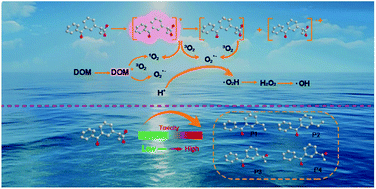当前位置:
X-MOL 学术
›
Environ. Sci.: Processes Impacts
›
论文详情
Our official English website, www.x-mol.net, welcomes your
feedback! (Note: you will need to create a separate account there.)
Study of the simulated sunlight photolysis mechanism of ketoprofen: the role of superoxide anion radicals, transformation byproducts, and ecotoxicity assessment
Environmental Science: Processes & Impacts ( IF 4.3 ) Pub Date : 2017-07-04 00:00:00 , DOI: 10.1039/c7em00111h Yingfei Wang 1, 2, 3, 4 , Wen Deng 4, 5, 6 , Fengliang Wang 1, 2, 3, 4 , Yuehan Su 1, 2, 3, 4 , Yiping Feng 1, 2, 3, 4 , Ping Chen 1, 2, 3, 4 , Jingshuai Ma 1, 2, 3, 4 , Haiying Su 1, 2, 3, 4 , Kun Yao 1, 2, 3, 4 , Yang Liu 4, 7, 8, 9 , Wenying Lv 1, 2, 3, 4 , Guoguang Liu 1, 2, 3, 4
Environmental Science: Processes & Impacts ( IF 4.3 ) Pub Date : 2017-07-04 00:00:00 , DOI: 10.1039/c7em00111h Yingfei Wang 1, 2, 3, 4 , Wen Deng 4, 5, 6 , Fengliang Wang 1, 2, 3, 4 , Yuehan Su 1, 2, 3, 4 , Yiping Feng 1, 2, 3, 4 , Ping Chen 1, 2, 3, 4 , Jingshuai Ma 1, 2, 3, 4 , Haiying Su 1, 2, 3, 4 , Kun Yao 1, 2, 3, 4 , Yang Liu 4, 7, 8, 9 , Wenying Lv 1, 2, 3, 4 , Guoguang Liu 1, 2, 3, 4
Affiliation

|
The aim of this study was to investigate the photolysis mechanism of ketoprofen (KET) under simulated sunlight. The results demonstrated that the photolysis of KET aligned well with pseudo first-order kinetics. Radical scavenging experiments and dissolved oxygen experiments revealed that the superoxide anion radical (O2˙−) played a primary role in the photolytic process in pure water. Bicarbonate slightly increased the photodegradation of KET through generating carbonate radicals, while DOM inhibited the photolysis via both attenuating light and competing radicals. Moreover, Zhujiang river water inhibited KET phototransformation. Potential KET degradation pathways were proposed based on the identification of products using LC/MS/MS and GC/MS techniques. The theoretical prediction of reaction sites was derived from Frontier Electron Densities (FEDs), which primarily involved the KET decarboxylation reaction. The ecotoxicity of the treated solutions was evaluated by employing Daphnia magna and V. fischeri as biological indicators. Ecotoxicity was also hypothetically predicted through the “ecological structure–activity relationship” (ECOSAR) program, which revealed that toxic products might be generated during the photolysis process.
中文翻译:

酮洛芬模拟阳光光解机理的研究:超氧阴离子自由基,转化副产物的作用和生态毒性评估
这项研究的目的是研究酮洛芬(KET)在模拟阳光下的光解机理。结果表明,KET的光解与拟一级动力学很好地吻合。自由基清除实验和溶解氧实验表明,超氧阴离子自由基(O 2 ˙ - )起到在纯水中光解过程中发挥主要作用。碳酸氢盐通过产生碳酸盐基团而略微增加了KET的光降解,而DOM则通过衰减光和竞争自由基。此外,珠江水抑制了KET的光转化。在使用LC / MS / MS和GC / MS技术鉴定产品的基础上,提出了潜在的KET降解途径。反应位点的理论预测来自前沿电子密度(FED),主要涉及KET脱羧反应。通过使用大型蚤(Daphnia magna)和费氏弧菌(V.fischeri)作为生物学指标评估处理过的溶液的生态毒性。还可通过“生态结构-活性关系”(ECOSAR)程序预测生态毒性,该程序表明在光解过程中可能产生有毒产物。
更新日期:2017-09-20
中文翻译:

酮洛芬模拟阳光光解机理的研究:超氧阴离子自由基,转化副产物的作用和生态毒性评估
这项研究的目的是研究酮洛芬(KET)在模拟阳光下的光解机理。结果表明,KET的光解与拟一级动力学很好地吻合。自由基清除实验和溶解氧实验表明,超氧阴离子自由基(O 2 ˙ - )起到在纯水中光解过程中发挥主要作用。碳酸氢盐通过产生碳酸盐基团而略微增加了KET的光降解,而DOM则通过衰减光和竞争自由基。此外,珠江水抑制了KET的光转化。在使用LC / MS / MS和GC / MS技术鉴定产品的基础上,提出了潜在的KET降解途径。反应位点的理论预测来自前沿电子密度(FED),主要涉及KET脱羧反应。通过使用大型蚤(Daphnia magna)和费氏弧菌(V.fischeri)作为生物学指标评估处理过的溶液的生态毒性。还可通过“生态结构-活性关系”(ECOSAR)程序预测生态毒性,该程序表明在光解过程中可能产生有毒产物。











































 京公网安备 11010802027423号
京公网安备 11010802027423号